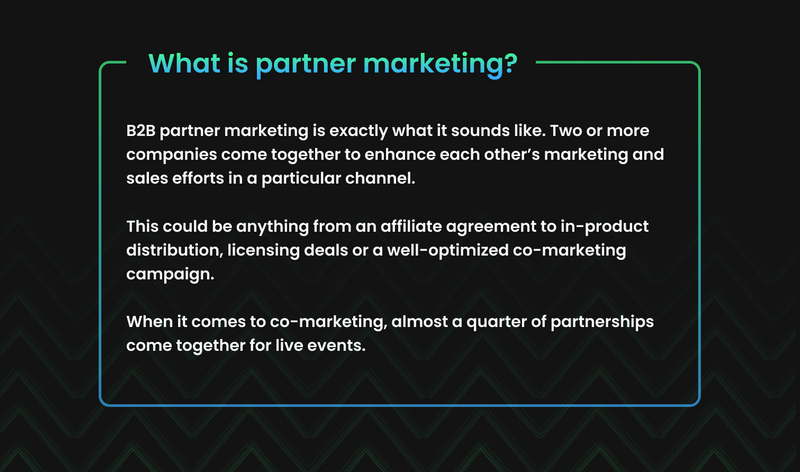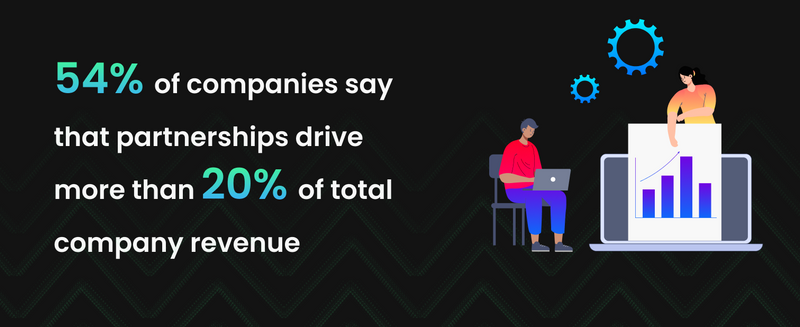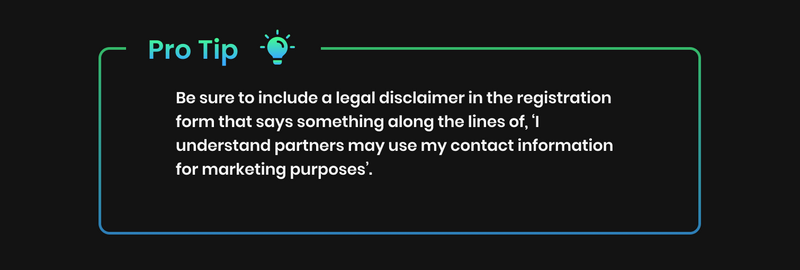Partner Marketing Events: Avoid Endless Emails with these 6 Simple Event Partnership Tips

Maximize Your Marketing ROI
Join 10,000 other marketers already getting the best tips on running engaging events that boost pipeline and create raving fans.
Today’s field marketers know the power of partnerships as a surefire way to bolster brand awareness and strengthen your pipeline—all at the same time. 👌🏾
And with a whopping 77% of companies reporting partnership development as central to their sales and marketing strategies, there’s no doubt partner marketing is here to stay.
“Partner events provide a great way to expand your reach, bring in new leads, and co-sell into accounts,” explains Darcy Dobis, Field Marketing and Community Manager at Teampay.
But more cooks in the kitchen means more complicated workflows. All too often, hazy goals and patchy processes make working with partners way more painful than it needs to be, even leaving some partners to wonder: Was it worth it?
From figuring out who creates what content, to tracking your leads and outcomes after the event—this ultimate guide to virtual B2B partner marketing events breaks down exactly how a successful event partnership should look, and what you need in order to make working together actually work.
What We’ll Cover:
- Why partner marketing events are worth the effort
- How to create pain-free partner marketing events in 6 simple steps
- Partner events don’t have to be complicated
Why partner marketing events are worth the effort
If you’re here, you probably already know all about partner marketing. But here’s a quick refresher, just in case.

Here’s why virtual event partnerships work so well:
- More Partnerships = More Revenue: 54% of companies that say partnerships drive more than 20% of total company revenue. By joining forces with a relevant partner, you not only combine knowledge and compound the value of your event content—you also give a serious boost to your bottom line.
- Build a strong event resource bank: From extra budget to new networks and attendee lists, the beauty of combining resources is you can boost your brand awareness without lifting a finger. In fact, a whopping 30% of companies will offer co-marketing reimbursement if their brand partner can prove ROI.
- Maximize your reach: Two heads are better than one—that’s why 51% of B2B companies use their partners to drive registrations.

How to create a pain-free partner marketing event in 6 simple steps
As a busy field marketer, unnecessary email ping-pong is definitely a pet peeve—and often, more partners mean more back-and-forth.
But what if there was another way?
With some solid pre-event organization and a few partner marketing best practices, you can minimize the endless email threads and get everyone on the same page, faster.
Step 1. Choose your channel partners wisely
As an event pro, you know that—no matter how hard you try—some partnerships just aren’t the right fit.
“Your goals may not always align with the potential partners’. When this happens, one side will do more work and the results will speak for themselves,” explains Adrian Cohn, Head of Marketing at Smartling.
Remember those group projects back in college, where one person ended up doing all the work but everyone got an A?
As a field marketing ace with over a decade of experience, Adrian has a solution that will make sure you offer enough value to secure the event marketing partnerships you want, while ensuring everyone deserves the A.
“Identify a smaller number of partners and go deeper on building a relationship with companies that have shared goals and are ready to do the work,” says Adrian.
Look for partners who have:
- The same target audience and ICP
- A similar sized (or slightly larger) audience and following
- A complementary product or offering
- A complementary brand message or value proposition
- A strong desire to see real growth and success from the partnership
As Adrian points out, having the “right partners” does NOT mean having the most partners. Remember, the more partners you have, the more channels and workflows you bring in.
Casting the widest possible net with your partner marketing might make sense for certain brand awareness or top-of-the funnel campaigns. But if you really want to move the needle on the pipeline, you’ll likely be better off taking Adrian’s advice and focusing your energy into deeper relationships with a small number of quality partners.

Step 2. Make it easy on your partners with regular check-ins and done-for-you content
Rome wasn’t built in a day—and your highest quality partnerships take time to develop too.
The secret is to set up key touchpoints that make it easy for your partners to pull their weight.
Here’s how Teampay’s marketing pro Darcy Dobis does it:
- “Set up weekly check-ins with all stakeholders a month before the event to keep everyone accountable.
- Create unique tracking links for all partners and share a document showing registrants that each partner recruited.
- Make it easy on your partners—if you’re hosting the landing page or leading the event, create email templates, banners, and social graphics that each partner can use in their promotions.” (More on this in a minute 😉).
You’ve already done the hard work of finding and securing exactly the right partners to support your revenue goals. Don’t make them regret their decision to work with you.
Make sure you’re ready to support your partners with a clear plan for how to set up and track your UTM links, landing page traffic, and more.
And if you really want to make them love (and keep working with) you, connect with your content team to create compelling, customized marketing collateral to help them promote registrations across the funnel.

Step 3. Set your boundaries and manage expectations
To show your partners you’re a worthy ally, your partnership approach needs to exude authority.
And authority comes from knowing what you want and exactly how you’ll get it.
From the way you manage partner roles, to how you delegate follow-up, it’s time to ditch the ad hoc systems and build a streamlined channel partner strategy.
Here are some of the key questions to think about as you set your goals (and expectations):
- How will you share leads after the event?
- Will you share the entire list for a sponsorship fee?
- Set up a lead sharing model to distribute the list only after each partner brings a certain number of leads to the table?
- Agree to share one lead for every new attendee registered?
- Only share the leads who attended a certain partner or sponsor’s session?

But lead sharing isn’t the only nut to crack. Here are some of the other event marketing tasks you’ll have to agree on early with your channel partners:
- Event promotion: Who shares what to which channels? And how often? Who’s in charge of creating and sharing the media pack? What role will video play?
- Branding and design: Who’s in charge of design and branding? How will partners be represented within the branding? Where will logos/brand names appear?
- Roles during the event: Who takes on which responsibilities? Will either partner be expected to take on any facilitation/speaker/host roles?
- Lead follow-up post-event: How will you track follow-up? When will follow-up take place?
- Event analysis and reporting: Who’s in charge of reporting? Which metrics do you need to track? Who will have access to the data? How and when will it be shared?
How you connect with partners shows them the quality of your brand values. By being firm but fair, they’ll know you care about your business (and theirs).
Plus, by agreeing on partner actions and follow-up straight from the get-go, you make it super easy to track leads, chat with partners, and attract attendees. Less time spent chasing your (and your partner’s) tail, means more time focusing on the tasks that matter.
So if all this seems like a lot of work, remember, planning who does what ahead of time can reduce the headache, make tracking leads easier, and make sure you never miss a closed-won opportunity from your virtual event.

Step 4. Centralize (and customize) your event
To make sure your virtual event packs maximum punch, you need to focus on centralizing your message and branding from day one.
Here’s how:
- Gather lead data in one place: No matter where your leads come from, their data needs to end up in the same place in order to generate the insights you and your partners need. Think: spreadsheets or data collection solutions (if you’re a Goldcast user, we collect attendee and account-level data for you automatically).
- Unify event branding: To make sure your virtual event comes under one awesomely branded umbrella, create some eye-catching branding that each partner can use throughout the event.
- Make it easy for partners to share event assets: You want to utilize your event partner’s reach, but they’re taking forever to get back to you. Sound familiar? Avoid this partner-chasing scenario by sharing a media pack with all partners and stakeholders as early as possible. Include social media templates, design assets, press releases, banners and suggested wording and messaging. Giving them all the tools they need from day one will increase the chances of a successful event.
Step 5. Drill down on data
Every event marketer worth their weight knows the strength of powerful data.
Gather crucial data around your core event KPIs, as well as deep account level insights, at every stage of the event marketing journey to track where you and your partners have gone right (and where you might’ve made a misstep).
Here are a few key metrics to track:
- Partner session attendance. Who attended each session and for how long?
- Attendee engagement. For example, did they reach out to chat 1-1 with any support staff/reps? Did they respond to any polls, or ask any live questions? (Check out our post on Increasing Attendee Engagement for more tips on boosting your engagement KPIs).
- Total number of leads. How many leads did each partner bring to the table?
- Post-event resource downloads.
- Product demos or live sales clicks.
Once you’ve gathered some solid data, it’s time to share it with your partners for a super efficient follow-up. You should already know who’s going to follow-up with who based on the agreements you set in your first meeting (remember Step 3? 😉).
Psst! With Goldcast you can now integrate Google Analytics to track leads from UTM links to your fully customizable Goldcast registration page.
Step 6. A word on sponsors
With 75% of sponsors constantly looking for new partnerships, it’s likely they’ll make up a large portion of the partners you work with.
To get the most out of these connections, make sure you treat them like the partners they are and work with them to boost attendance from the get-go:
- Ask them to share the event via their social media channels and email lists.
- Remember the media pack we chatted about in Step 4? Share it with sponsors to make promoting your event easy to do.
- Check in regularly with sponsors to find out how they’re getting on with promoting the event (and push them to do more if needed).
The workflow for sponsors looks very much like your other partner and channel marketing workflows, but you’ll probably want to focus on slightly different metrics.
Marketing ace Ashesh Satvedi, Head of Global Digital Events at Box, explains which metrics to track:
According to Ashesh, when sponsored partners are involved in your event, you need to measure:
- How many booth visits each partner received
- Attendee engagement within the booths, including how many attendees:
- Chatted with the booth rep
- Downloaded specific resources
- Booked a meeting
Virtual booths may not be the most attention-grabbing of your sessions, but there’s still a time and a place for them.
Try using a virtual event tool that allows you to organically (and automatically) push attendees to sponsor booths after a session, to guarantee your sponsors some footfall, and make it feel like a natural, integrated part of the event. (Psst! We can think of one event platform that does this for you 😉).

Partner events don’t have to be complicated
It goes without saying that a streamlined partnership marketing strategy will make your (and your partner’s) life easier.
From gathering lead data in one place to unifying your event branding, there are a million ways to strengthen your event partnerships for the better and make co-marketing feel easier than ever.
When you’re ready for a top virtual event technology platform that brings it all together, give Goldcast a try. Our customizable event branding features will help you and your partners come as close to an in-person event as possible, while giving you all the rich data only a digital platform can offer. Learn more about who we are and what we do, or schedule your personalized demo today to see how we can improve the performance of your online event.
Transform Your Video Marketing with AI
Stay In Touch
Platform
Resources
© 2025 Copyright Goldcast, Inc. All rights reserved.





 Upcoming Events
Upcoming Events Event Series
Event Series On-Demand Events
On-Demand Events

